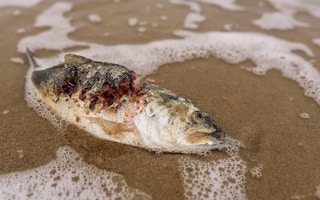Activists urging the Vietnamese people to protest the government’s sluggish reaction to an environmental disaster that killed tons of fish along Vietnam’s central coast say a barrage of criticism by a major state media outlet will do little damage to their cause.
“It is an old trick that nobody believes anymore,” blogger Nguyen Thuy Hanh told RFA’s Vietnamese Service. “I don’t think anybody would believe that, and I can assure you it was a dirty defamation.”
In an unusual move, state broadcaster VTV1 used an 11-minute segment Sunday night to warn the public to stay away from demonstrations about the disaster. The segment was picked up by other news outlets.
While government experts have claimed that a “red tide,” or a release of dangerous chemicals by humans, could have been the cause, many Vietnamese blame the $10.6-billion Formosa steel plant in Ha Tinh province and are dismissive of government explanations.
Prime Minister Nguyen Xuan Phuc has promised a thorough investigation of the disaster, and he pledged to bring justice to those found responsible, but there appears to be little confidence among many in Vietnam that he will do so.
“
They have distorted the truth, cut and pasted stories to vilify and denounce demonstrators and intellectuals relating to the mass fish deaths in the central region.
Nguyen Quang, Vietnamese activist
The one-party state has cracked down on dissenting voices before, but the dedication of a segment on the nation’s largest TV station that named names and connected dissenters with subversive activity added a new page to the government’s play book.
“Riot and overthrow?”
“Their intention to abuse and disturb was revealed when many subjects called for using knives and petrol bombs to attack the functional forces and to overthrow the authorities,” the narrator of the VTV report intoned, according to a Reuters report.
“Many people may ask what kind of peaceful marches are they … Is this possibly a preparation for a riot and overthrow?” the voice-over asked.
The warning comes as protesters tried to rally for a third successive Sunday. Tight security in Hanoi and Ho Chi Minh City prevented major rallies, but that didn’t stop small groups of demonstrators from gathering, according to social media.
“They have distorted the truth, cut and pasted stories to vilify and denounce demonstrators and intellectuals relating to the mass fish deaths in the central region,” Nguyen Quang told RFA.
The former director of the now-defunct Institute of Development Studies think tank and a well-known activist in Vietnam, contends that the government has less control over public opinion than it did in the past.
“Before, people had no access to foreign TV channels, or the internet, and they had no other sources of information,” he said. “The government, with their monopoly on media could succeed in distorting information brainwashing people with their propaganda, brainwashing people and making people believe everything said by the government was true.”
While the government’s control over the media may not be complete, it still holds substantial power over news outlets.
“Of course it still has some effect on quite a large number of people,” he said. “But as soon as they have access to independent sources of information, things will change.
Copyright © 1998-2014, RFA. Used with the permission of Radio Free Asia, 2025 M St. NW, Suite 300, Washington DC 20036.

















